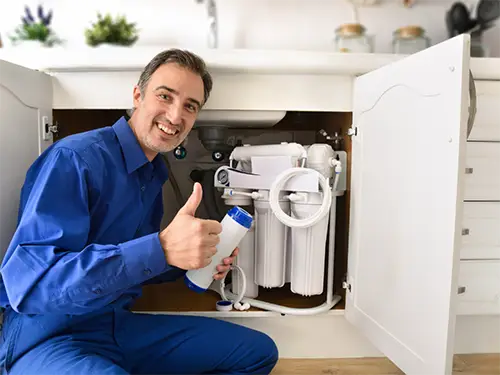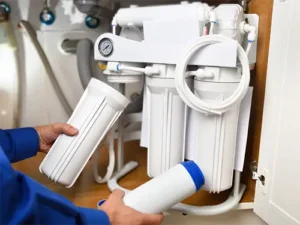 Reverse osmosis (RO) systems are the go-to choice for those seeking clean, purified water for their homes or businesses. If you want to remove contaminants like sediments, chlorine, or microplastics from your water, these systems work well.
Reverse osmosis (RO) systems are the go-to choice for those seeking clean, purified water for their homes or businesses. If you want to remove contaminants like sediments, chlorine, or microplastics from your water, these systems work well.
But like any system, they don’t last forever. On average, a reverse osmosis system’s filters and parts will last between 2 to 5 years before needing replacement.
In this article, we’ll break down how long various components of an RO system last, what impacts their lifespan, and how to ensure you’re getting the most out of your system.
Key Takeaways
- The average lifespan of an RO system’s filters ranges from 6 months to 5 years, depending on the component.
- Regular maintenance, such as filter replacement and system cleaning, can prolong the life of your system.
- Water quality, frequency of use, and environmental conditions all play a role in determining the lifespan of RO filters.
- Investing in high-quality filters and proper upkeep will ensure long-lasting performance.
Understanding Reverse Osmosis Systems
The heart of a reverse osmosis system is the semi-permeable membrane that purifies water by allowing water molecules to pass through while blocking contaminants. But there’s more to it than just the membrane.
Most systems involve multiple filtration stages, both before and after the water hits that membrane. These pre- and post-filters are critical for maintaining water safety and quality, capturing sediments, chlorine, and other impurities along the way.
One thing you should know: RO filters wear down over time. They become less efficient as they get clogged with contaminants, which is why filter replacement is key to keeping your drinking water systems tasting fresh and clean.
Stages of a Reverse Osmosis System
RO systems have a few critical stages of filtration. Let’s walk through them to get a clear understanding of how each stage works and what kind of maintenance they need.
Pre-Filter (Sediment Filter)
The pre-filter, often referred to as a sediment filter, is your first line of defense. It catches larger particles like sand, dirt, and rust before they can damage the sensitive RO membrane. A clogged pre-filter won’t just reduce your water pressure; it can also shorten the life of your RO membrane.
Replacement frequency: About once a year, or according to manufacturer guidelines.
Carbon Filter
The carbon filter targets chemicals like chlorine, pesticides, and lead. Chlorine, in particular, is notorious for damaging RO membranes over time. The lifespan of the carbon filter depends on the quality of carbon used, the volume of water passing through, and the environmental conditions where the system is installed.
Replacement frequency: Every 6-12 months, depending on water usage.
Reverse Osmosis Membrane
This is where the magic happens. The RO membrane is responsible for purifying the water by filtering out the tiniest particles, including heavy metals, bacteria, and microplastics. While these membranes can last up to five years, some users report them lasting over a decade with proper maintenance. Keeping the pre- and carbon filters in good shape directly impacts the life of the membrane.
Replacement frequency: Every 2 to 5 years, depending on water quality and maintenance.
Final Filtration (Post Carbon Filter)
This last stage ensures that the water tastes great and is safe to drink. The post-filter, often a carbon filter, removes any lingering odors or tastes that might have been missed earlier in the process.
Replacement frequency: Once a year, like clockwork.
Importance of the Reverse Osmosis Membrane
 The membrane is the star player in the reverse osmosis process. If it’s not working correctly, the quality of your water will suffer. You’ll know the membrane is on its last leg when you notice changes in water pressure, taste, or even color. Regularly checking and replacing it ensures your drinking water remains pure.
The membrane is the star player in the reverse osmosis process. If it’s not working correctly, the quality of your water will suffer. You’ll know the membrane is on its last leg when you notice changes in water pressure, taste, or even color. Regularly checking and replacing it ensures your drinking water remains pure.
Ignoring these signs could lead to bigger problems down the line, including clogged filters and even damage to the system’s other components. Routine maintenance will prolong the life of the RO membrane and keep your system working at peak efficiency.
How Long Does a Reverse Osmosis System Last?
The longevity of an RO system depends on several factors, including water quality, usage, and maintenance. Hard water, for example, can wear out filters faster. If your household uses more water than average, you’ll also need to replace filters more frequently. And let’s not forget the environmental impact—higher temperatures and humidity can lead to faster filter degradation.
Here’s a general guideline for how long different RO components last:
- Pre-Filters (Sediment): 6 to 12 months.
- Carbon Filters: 6 to 12 months.
- Reverse Osmosis Membrane: 2 to 5 years.
- Post-Filters: 1 year.
To get the most life out of your system, make a habit of checking your filters and replacing them as recommended by the manufacturer. A little effort goes a long way in keeping your water clean and your system running smoothly.
How to Extend the Lifespan of a Reverse Osmosis System
Keeping your RO system in top shape doesn’t require a lot of effort, but it does need consistency. Here are some simple tips:
Regular Cleaning and Maintenance
Clean the filter housings regularly to prevent sediment buildup. Dirty housing can impact water quality and reduce the system’s efficiency. Also, check for any signs of damage or leaks that could affect performance.
Replace Filters on Time
Don’t procrastinate on filter replacements. Pre-filters, in particular, trap larger particles that can cause damage if not removed in time. Staying on top of these replacements keeps the entire system running smoothly. Regular cleaning of your system can also help extend its life, but it should never replace filter changes.
How to Clean a Reverse Osmosis System
Cleaning your RO system annually can keep it functioning efficiently for years. Follow these steps for a thorough clean:
- Shut off the main water valve and the pressure tank.
- Drain the system completely by opening the RO faucet.
- Replace the pre-filter and post-filter. These are the filters most likely to be clogged with sediment or other debris.
- Inspect the RO membrane and replace it if it shows signs of wear.
- Check for auxiliary filters, like remineralization filters, and replace them if needed.
- Turn the main water valve and pressure tank back on after cleaning.
- Flush the system until the water runs clear. This could take a few minutes.
- If the membrane was replaced, flush the tank twice before using the water.
Regular cleaning not only extends the life of your system but also ensures you’re getting the best-tasting water possible.
Water Filtration Solutions in Niceville, FL
![]() Benjamin Franklin Plumbing provides a wide range of water filtration services, including top-notch reverse osmosis installations. If you’re looking for a high-quality system installed quickly and efficiently, give our punctual plumbers a call. We pride ourselves on respecting your time and your home, getting the job done right without disrupting your schedule.
Benjamin Franklin Plumbing provides a wide range of water filtration services, including top-notch reverse osmosis installations. If you’re looking for a high-quality system installed quickly and efficiently, give our punctual plumbers a call. We pride ourselves on respecting your time and your home, getting the job done right without disrupting your schedule.
Final Thoughts
Reverse osmosis systems are a fantastic way to ensure your drinking water is clean and safe. With regular maintenance and filter replacements, your system can last a long time.
Staying proactive with care keeps your system efficient and your water pure. If you are unsure about your system’s maintenance schedule, ask for help. Professionals can assist with filter replacements to keep everything running well.
FAQs
Before we wrap up, here are some frequently asked questions about reverse osmosis systems and filters. If you’re looking to get the most out of your RO system, these FAQs should help clear things up.
How often should I replace my reverse osmosis filters?
Typically, pre-filters and carbon filters should be replaced every 6 to 12 months, while the RO membrane lasts 2 to 5 years. Post-filters should be changed once a year.
Why does my reverse osmosis system produce less water over time?
This usually indicates that your filters or membrane are clogged. Reduced water pressure is often a sign that it’s time to replace one or more filters.
Can I clean my reverse osmosis membrane?
In most cases, it’s better to replace the membrane when it gets dirty. While some cleaning products are available, they aren’t always effective and could reduce the membrane’s efficiency.
Is reverse osmosis water safe to drink?
Absolutely! RO water is filtered to remove contaminants like lead, chlorine, and even microplastics, making it a great choice for clean drinking water.
How long does it take to fill the storage tank of an RO system?
This depends on the system’s size and water pressure. Typically, it takes 2 to 4 hours to fill a storage tank, but it may take longer if filters are clogged or the water pressure is low.
If you have more questions about reverse osmosis, please contact Benjamin Franklin Plumbing.